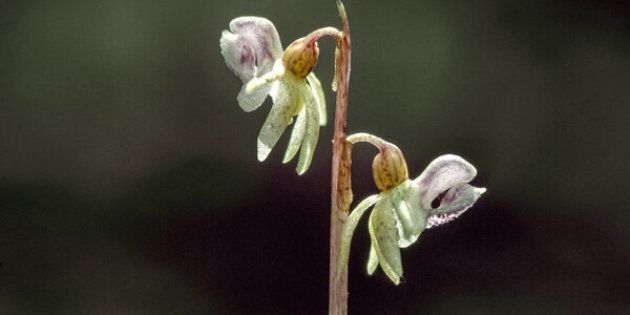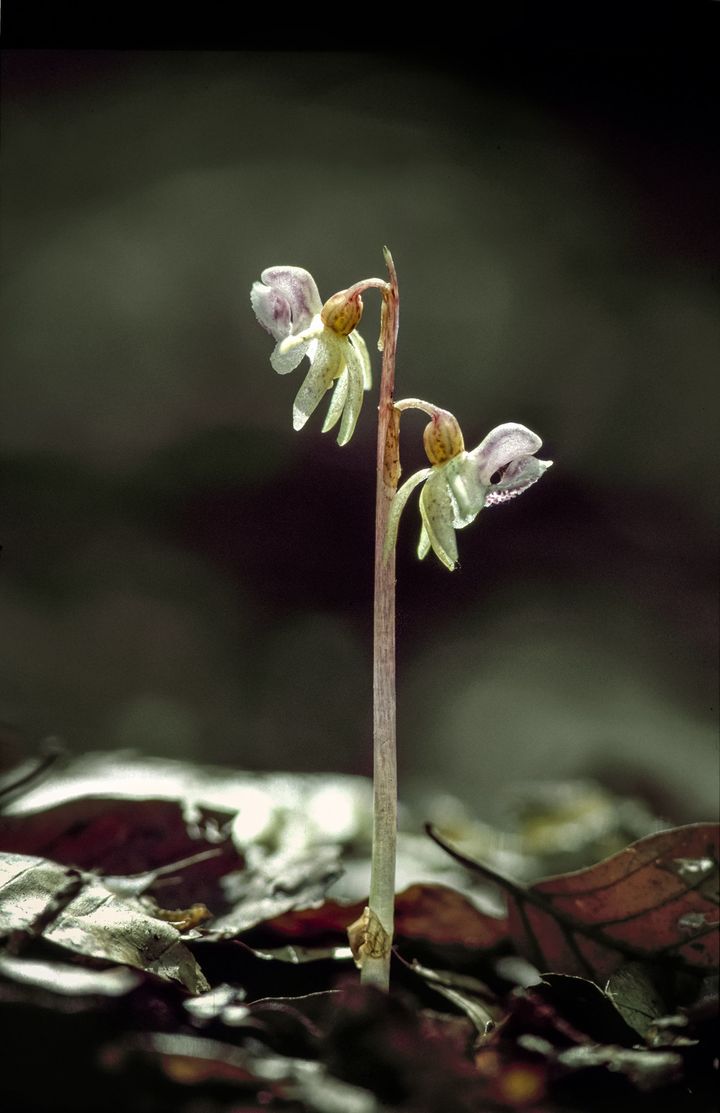
This post originally appeared on National Geographic.
You look. It’s there. Then it’s not. Decades go by, and people are prowling the woods, eyes down, hunting for it—crawling, searching, losing hope, and then, all of a sudden, there it is again! In a totally unexpected spot, far from the last sighting, hiding in the dark, barely as tall as your thumb, leafless, probably the rarest plant in Great Britain. It’s known as the ghost orchid, and when it shows up, people go nuts.

I’m talking about plant people.
Let the twenty-somethings hunt for Pokemon characters on their smartphones. This is an older game of hide-and-seek—just as obsessive and every bit as crazy.
How It All Began
It starts back in 1855, when a Mrs. Anderson Smith (I see her in a full skirt, edging her way down a steep dirt trail to a silvery brook in Herefordshire, England) catches sight of a teeny blossom. It’s barely visible, shaded, hemmed in by ferns and nettles. She leans over, plucks it, doesn’t know what it is, and takes it to a local plant lover, who tells her it’sEpipogium aphyllum, a leafless orchid (different, it should be noted, than the Polyrrhiza lindenii featured in The Orchid Thief). Something new in England, it’s placed on exhibit—and then, just as suddenly, disappears. “Rumour says it was accidently destroyed when the room in which it was exhibited was cleared,” the local paper reports.
The orchid stays missing. Twenty years pass. There’s a second sighting in a different plot of woods miles from the first, then another 20-year pause, then another sighting, and by the time World War I ends, the plant has a reputation for once-in-a-generation appearances, sometimes in Scotland, then in England, then in Wales. Plant lovers wonder where it will turn up next and who’s carrying its seeds. Flies? Bees? Birds? Nobody knows. (The seeds are very, very small. They wouldn’t be bird food.)
A Little Girl Gets Lucky
By 1926, so many people know about the ghost orchid, you can feel the hunt getting shrill. The Cardiff National Museum in Wales has a diary written by avid plant hunter Eleanor Vachell, who breathlessly describes a May morning when an official at the British Museum in London calls a friend of hers, Mr. Francis Druce. The official wants to know if anyone’s gotten wind of a new find—the first in years.
Druce, a local plant hunter, tells the museum that, yes, at this very moment, he’s got a fresh-from-the-forest ghost orchid stem in his house—in a vase. He’d gotten it from a little girl who’d found it on her own. The British Museum says, “Can we have a sample?” and quickly recruits Druce to conduct a search. Druce calls our diarist, Vachell.
Game On!
“Excitement knew no bounds,’ Vachell wrote. “[A] taxi was hurriedly summoned,” and the team walked into the woods to see if they could find another blossom, but wherever they looked—“though they spread out widely in both directions”—they found nothing.
They needed the girl.
Asking around they found a “Mrs. I,” who answered her door to say that, yes, she knew about the orchid (in fact, she’d made a sketch of the plant, which she was very happy to share with the museum), and she knew the girl. She gave them her address.
The girl was in. What’s more, she had a second stem. It was in plain view, sitting in a vase. Druce asked if she wanted to contribute her find to science. I’m guessing he told her about how exciting it would be to share her find with the British nation, but the girl—never named in the diary—said no. And kept saying no.
“In vain did Mr. Druce plead with her to part with it but she was adamant!” The stem was hers. She had no intention of sharing it. (Apparently, even in 1926, a determined little girl could hold her own against equally determined adults. No parents are ever mentioned.)
The girl was, however, willing to take the adults back to the woods to lead them to the very place where she’d made her discovery.
So back they went, Druce, Vachell, and the discoverer. Though they got down on their knees at the very spot where the blossoms had appeared, though they rummaged and searched, and though a few days later Vachell went back and dug down to the rootlets to see if any buds were coming up—the plant was done. There would be no more flowers. Game over. Chapter closed.

So There You Are!
There have been several chapters since. The orchid reappeared (in a different locale) in the 1950s, then again in the ‘80s, and most recently—after a 23-year pause—in 2009. A plant hunter and motorbike company owner named Mark Jannink tracked down a single specimen with just one small white flower on top. It was only about six inches tall. “The plant was so unobtrusive,” said London’s Independent, “that it was invisible from a few yards away. On spotting it, Jannink exclaimed: ‘Hello you—so there you are!’”
Jannink had been hunting for months, trying to narrow his search to a few likely spots, according to a museum account:
He researched all previous Ghost Orchid discoveries—their preferred habitat, time of flowering and weather patterns—then staked out ten possible sites in the West Midlands, visiting them every two weeks throughout the summer of 2009, following the first cold winter for many years. Finally in September, he discovered one small specimen—causing great excitement amongst botanists, as the Ghost Orchid had been declared officially extinct in 2005!
Yup, it had been declared dead. But no more. The great science writer Richard Fortey wrote recently that it’s just extremely elusive, maybe the most elusive plant in Britain. “Since the flowers blend almost perfectly with beech leaves as a backdrop,” he says, it’s a double-ghost, nearly transparent, and camouflaged to boot, with a mysterious ability to leap great distances. “Nothing I have read explains how a plant with such minute seeds can apparently jump so dramatically from place to place. There is something almost spooky about it,” Fortey writes.
And talk about spooky: It has no chlorophyll. Almost every plant in the forest has green cells that photosynthesize and turn sunshine and air into proteins and sugars. Not this little guy. It clearly doesn’t need light; it grows in deep shade where no other plants can grow. How it lives was a mystery (turns out, it’s a parasite; it’s stealing energy from a fungus below) but the best thing about it―-is that it persists.
For the last 150 years, it has taunted, flirted, hidden, played dead. Mostly, it’s missing, and yet we’re getting used to the idea that even when it gone, it’s always there. Or is about to be.
And in a shrinking world, that’s nice to know.
Robert Krulwich is cohost of Radiolab, WNYC’s Peabody Award–winning program about “big ideas” and now one of public radio’s most popular shows. It is carried on more than 500 radio stations, and its podcasts are downloaded over five million times each month. In Curiously Krulwich, Robert looks for “the little things that catch my eye—that when I lean in, get bigger, richer, and much more compelling.” You can see more of his work at radiolab.com and follow him on Twitter@rkrulwich.
More from National Geographic:
272-Year-Old Shark Is Longest-Lived Vertebrate on Earth
Not-So-Dark Ages Revealed at King Arthur Site
